Wrigley Field
Wrigley Field, the current home
of the Chicago Cubs baseball team, was originally constructed in 1914 for
$250,000 in an astonishing 6 weeks.
Designed by Zachary Taylor Davis, who designed Comisky Park four years earlier
for the Chicago White Sox, the stadium seated between 14 and 20,000 and was
originally named Weeghman Park for the Whales baseball team, of the Federal
League, which was the first tenant.
In 1915 the Federal League folded and the Chicago Cubs moved from their
dilapidated field at West Side Grounds to the newly constructed stadium and
when Wrigley, who had been a partner in the club, gained control of the Cubs in
1918, he renamed the stadium to Wrigley Field in 1926.
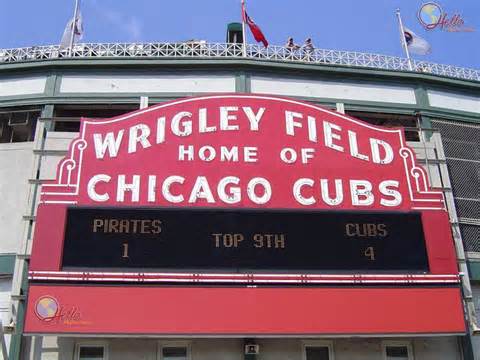
Distinctive Wrigley Field Features:
Recessed Walls, or wells as they are
known, are located in left and right field and when the famous Cross Winds of
Chicago, which blow off Lake Michigan, increases in intensity, these wells can
create unusual and unpredictable wind currents which cause the ball to react in
crazy manners.
The Basket which is unique to Chicago, is a net running the entire length of
the outfield and was designed to prevent fans from falling onto the field from
the bleachers. Because the netting runs 2 foot above the wall and is anchored 7
to 10 feet below the top, creating a basket, the actual dimensions listed on
the walls, as far as hitting a home run, is not accurate, its actually less
distance from home plate as a ball landing in the net is considered a Home Run.
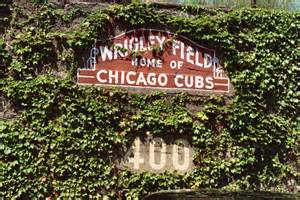
Wrigley Field Ivy - Covered Walls, which at the time the ivy was installed
was not unique, now is famous and adds to the historic glamour of the ball
park.
The Ivy was installed in 1937 as part of a beautification plan for the
bleachers, which were installed the same year, and it’s rumored General Manager
Bill Veeck got the idea of the ivy from the Donnie Busch Stadium in
Indianapolis.
The Ivy, which is a combination of Boston Ivy & Japanese Bittersweet, can
endure the harsh Chicago winters, which many other ivy species could not.
However, the ivy is Not leafed out at the time the baseball season begins and
the brick wall is distinguishable through the ivy vines, but as the season
proceeds the ivy flowers into its distinctive green and totally hides the brick
wall.
Special ground rules are implemented due to the ivy. Should a baseball hit the wall and become lodged in the ivy, and if the outfielder cannot locate it because it’s hidden in the ivy, the fielder will raise both hands over his head and an umpire will go out to see if in fact the ball is lost in the ivy. It is then ruled a Ground Rule Double.
One misnomer of the Ivy is that it cushions a player’s impact against the brick wall if he runs into it … it does not.
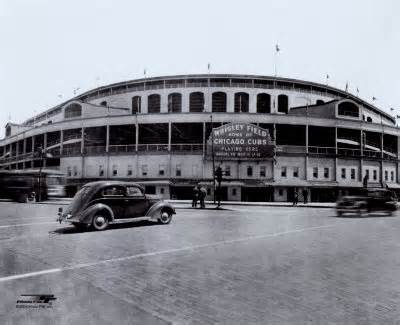
Wrigley Field in the 40's
Roof Top Seating:
Many old baseball parks were built in the middle of residential areas, which
were multi storied tenant houses or apartments. The roof tops of these adjacent
buildings offered an excellent view of the baseball game from which the game
could be viewed for Free.
Similar situations existed in other cities, such as Philadelphia, which created
rifts between the residences and the ball club. The Phillies constructed a
Spite fence between the stadium and the residences of Shibe Park, which ended
in a bitter dispute.
The Cubs however, took a different approach to the roof top viewers, across
Waveland and Sheffield, who held cook outs and were populated with a reasonable
amount of fans. They quietly ignored them. However, in the 1990s owners of the
apartment buildings began constructing bleachers and charging people to view
the game. This is when the Cubs began to protest and as the number of bleachers
increased, the more vocal the Cubs became.
In 2003, with the threats of legal action, the Cubs, apartment owners and the
city reached a peaceful solution which was amicable to all parties. The
building owners agreed to share some of the revenue derived from their
bleachers and the city allowed the Cubs to build additional bleachers over the
sidewalks of property located along Clark & Wave and Seminary Avenue.

Wrigley Field Seats
Some of the Roof Top Bleachers have become famous in their own right. The Lakeview Baseball Club, which sits across Sheffield Avenue, displays a large sign which reads “Eamus Catuli !” which is Latin for“Let’s Go Cubs!”
The Infamous Wind, of Wrigley which
blows off Lake Michigan ( located less than a mile to the East ) changes as the
season proceeds playing a major role in the games.
In April and May, the winds blow in from the North East which prevents balls
hit hard enough to be home runs, from leaving the park and result in outs.
In the Summer Months the wind on a sunny breezy day, will come out of the South
or Southwest, which creates a Blowing Out wind which turns normal fly ball outs
to become Home Runs.
There is an additional Wind variety known as a Cross Wind, which normally blows
from the Left field corner to the Right field corner and can create chaos on
high hit fly balls.
Depending on the direction and strength of the prevailing wind, Wrigley
Field can become a hitter’s park, known as the “friendly confines of Wrigley,”
or a pitcher’s friend by keeping balls in the park or an outfielder’s worst
nightmare because of the swirling upper winds creating havoc on fly balls.
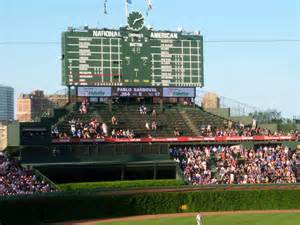
Historical Hand Turned Score Board:
The hand turned score board was installed in 1937 when additional bleachers
were installed and with the exceptions of a few minor updates, remains the same
as the original. Since it was constructed above the bleachers and not at ground
level like similar scoreboards, it has Never been hit by a baseball.
The scoreboard is constructed out of Sheet Steel with cut outs which allow the
insertion of numbered plates which indicate scores and innings. The numbered
plates are constructed out of steel, painted Forest Green with White numerals,
while the Box Score numbers are painted Yellow.
A clock, one of a few modifications, was installed on the top of the scoreboard
in 1941 and has Never lost time in its 70 year existence.
A set of lights facing onto the scoreboard was installed in 1988 when night
games were introduced and an electronic message board was added beneath the
scoreboard at the same time.
The replacement of a ticker tape machine, which the scoreboard operator used to
update scores around the league, with a computer, more or less completes any modifications
of the original scoreboard.
The Main Entry Marquee is located directly over the Main Entrance of the
stadium and is probably the most familiar icon of the exterior.
The marquee was installed in 1934 and was painted Blue and used changeable
letters, similar to those used on the scoreboard, to announce upcoming games
and opponents. The sign read “Home Of The Cubs” until 1939 when it was changed
to “Home Of Chicago Cubs”.
In the 1960s the color of the marquee was changed to Red and in 1982 an electronic
message board was installed replacing the hand turned letters.
Lights and Wrigley Field were not always
spoken in the same sentence, not that lights were not considered. In 1942
Wrigley had planned to install lights, but World War II began and the project
was scrapped.
The tradition of playing only day games at Wrigley became deep rooted and it
wasn’t until 1988 the team succumbed to pressure from the MLB and installed the
lights. Although MLB forced the Cubs to install lights, or else never be able
to host post-season games, the number of games are still restricted by the city
council.
August 8th was the first attempt to play a night game between the Cubs and the
Phillies, but it was rained out in the 3rd inning, resulting in the 1st night
game being played on August 9th, 1988.
Summation of Wrigley Field:
Location: 1060 West Addison Street Chicago, ILL. 60613
Broke Ground: March 4th 1914
Opened For Play: April 23rd 1914
Surface: Grass
Capacity: + or - 42,311 standing room only
Field Dimensions:
Left Field = 355’
Left Center Field = 368’
Center Field = 400’
Right Center Field = 368’
Right Field = 353’
Wrigley Field to Baseball Stadiums
Check Out The Cubs & Wrigley
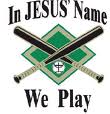
New! Comments
Have your say about what you just read! Leave me a comment in the box below.